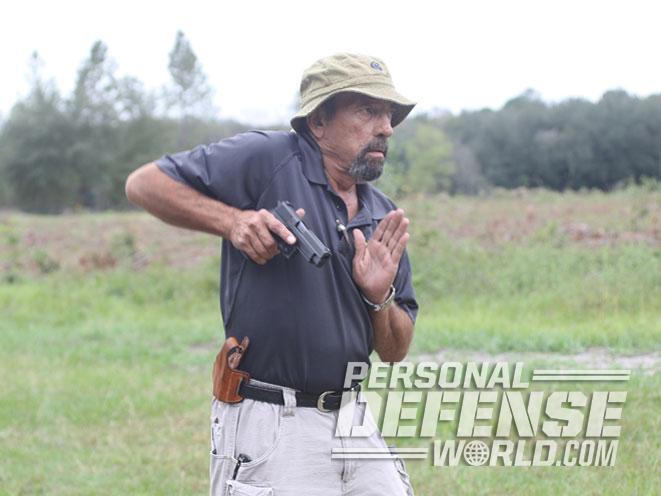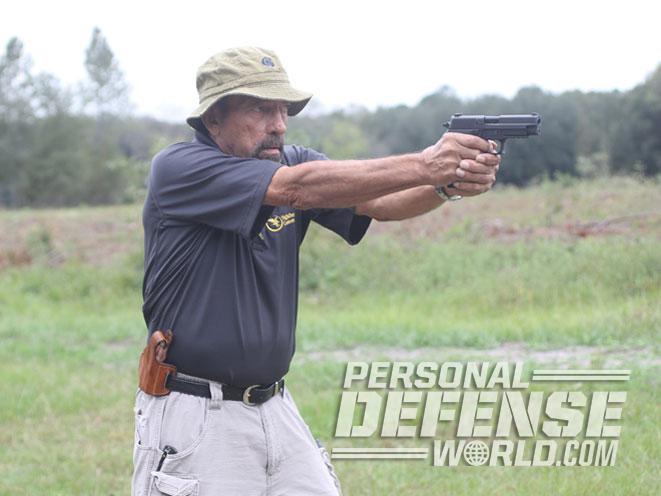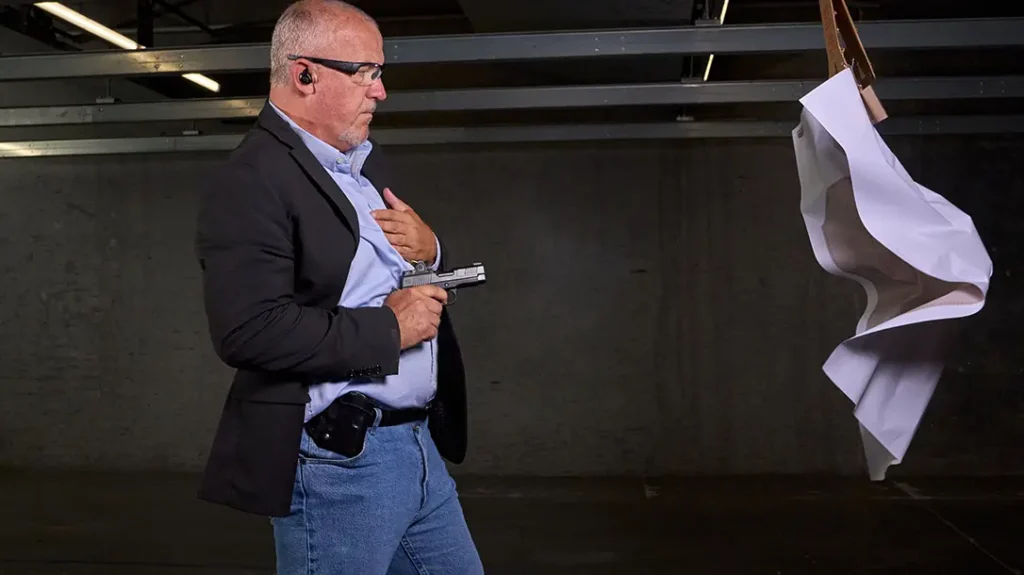The ability to swiftly draw and fire is a critical survival skill for cops, soldiers and law-abiding armed citizens alike. Of course, all these “good guys with guns” have something else in common: They’re all more likely to have to draw and cover a threat zone without firing a shot than they are to have to draw with the knowledge beforehand that they’ll have to shoot—and hit well—or die.
These are important background thoughts to have in mind as we discuss a current controversy in the world of defensive pistolcraft, the “press-out” technique versus the “index” technique. Terminology tends to get muddy here, so bear with me as we try to define our terms for purposes of the discussion.
Types Of Draws
Advertisement — Continue Reading Below

The master instructor most often identified with the “press-out” technique is Todd Louis Green, whom I consider one of the brightest stars in the current generation of firearms trainers. In the press-out, the shooter brings the pistol straight up out of its holster, high to the chest, and gets its muzzle downrange on the target as soon as possible. The shooter then drives the pistol straight forward toward the target, and if the decision to shoot has been made, starts applying trigger pressure as soon as the shooter can see the gun is on target. Perfectly applied, this technique results in a fast, aimed shot striking dead-on as the shooter’s stance reaches full arm extension.
The “index” technique presumes that the shooter has built enough repetitions that he or she reflexively brings the sights level with the eye and can therefore achieve a visual index—aimed in on target—more toward the end of the movement sequence that achieves the firing stance. This is the stance favored by such great champions as Ron Avery.
RELATED STORY: Massad Ayoob’s 5 Methods of Concealed Quick-Draw
Advertisement — Continue Reading Below
Here’s a good way to visualize each. For the press-out, picture a capital letter “L” tipped forward to the right to 90 degrees. The short leg of the “L” is the gun coming up out of the holster and up to chest level, with its muzzle pointed downrange when it reaches that point. The long end of the “L” is the extension of the arms, with the “press out” toward the target or the threat.
For the index draw, picture the gun moving in a straight line upward from the holster toward the target at about 45 degrees. It’s what you would put on paper if someone asked you to draw a diagram of an escalator. In fact, some in the handgun world actually call it the “escalator draw,” an exquisitely descriptive term for it.
Strong Points
Advertisement — Continue Reading Below

One advantage of the press-out is that, early in the draw, it brings the gun close to the upper body and level with the target, aka the threat. You very quickly come into a retention position in which you can fire on a fast-closing threat at near-contact distance and still achieve reasonably effective hits.
Another plus for the press-out is that it works great if there is an obstacle close in front of you. You are behind the steering wheel when the carjacker or road-rager comes at you with his own gun drawn, or seated at a dinner table when the lethal threat makes itself known. An “escalator draw” is likely to be stalled when your gun or hands bang into the steering wheel or dashboard, or the table, and may even result in you firing prematurely and wounding yourself. The L-shaped movement pattern of the press-out draw will most likely keep that from happening. The same will be true if you have to draw when the attacker is almost on top of you, and can use his free hand to block your “escalator” draw but may not be able to reach your hand or gun and stop you from firing to save your life if you’ve used the L-shaped movement of the press-out.
RELATED STORY: Perfect Pocket Draw – Quick-Draw Essentials
Advertisement — Continue Reading Below
If you use a double-action handgun with a long, heavy trigger pull, the press-out gives you more time on target to start bringing the trigger back for the shot you knew you would have to fire before you began the draw. A few years ago, at one of Tom Givens’ national tactical conferences in Tulsa, Oklahoma, I watched Todd Green use the press-out drill with his HK P30 .45 to beat the rest of us in a very fast-paced combat match, with many of us, including myself, using the escalator draw. Todd is a big fan of DA/SA semi-autos, having given much input to Beretta and Sig Sauer when he worked with them, and he used that well-developed technique to victorious advantage with his DA/SA HK that day.
Of course, the index or escalator draw also has advantages. Its big advantage is that it is faster. It’s simple geometry: The fastest route between two points is a straight line. The escalator draw, in which the gun starts coming upward and outward toward the target as soon as it clears the holster, has a shorter route to travel before the shooter achieves the intended firing stance. The difference is a fraction of a second, but fractions of a second
count in gunfights and can make the difference between life and death.
Which To Use
Advertisement — Continue Reading Below

The index or escalator draw is problematic if there’s an obstacle in front of you: that steering wheel we talked about, that table you are seated at, or that assailant who’s virtually on top of you. The press-out, because it brings the gun close to you before extension, clears those first two obstacles and puts you into a retention firing position for the third, seems to be a logical choice as the first draw to learn. That’s why it’s the draw I teach to students in my first-level courses. Its only real downside is a small loss in draw-to-shot time at greater distances and in circumstances where the draw won’t be impeded. We get more into the index draw in advanced classes, where speed is greatly accelerated and fractions of a second loom larger in importance.
If the field in front of you is clear, you’ll get the gun on target just a bit faster and perhaps get the bullet where it needs to go just a little bit sooner, with the index draw.
RELATED STORY: 37 Holsters For Every Style Of Concealed Carry
Advertisement — Continue Reading Below
Your choice of handgun plays into it somewhat, too. Todd Green, the press-out guy, won fame shooting DA/SA autopistols. Ron Avery, who favors the index draw, won his championships with short-trigger-stroke 1911-type pistols that doesn’t need as much time to prep the trigger.
In the end, it’s not really an “either/or” proposition. The ideal answer is to have both techniques in your toolbox, and use the one best suited for your need at the moment. There is room in each for subtly different, “hybridized” draw techniques.
If your opponent throws a right cross at you, you’ll want to block or parry with your left hand; if he comes in with a left hook, you’ll need to block or parry with your right. If he’s close to you, you may want to deliver a knee strike; if he’s farther away, a sidekick.
Advertisement — Continue Reading Below
So it is with the draw. It’s not either/or. It’s “be able to do either type of draw on demand.” And remember: Your practice should encompass the fact that you’re more likely to need to take the opponent at gunpoint than to shoot him, so a big part of your practice should involve keeping the finger out of the triggerguard until you have consciously determined a need to unleash defensive gunfire.


































